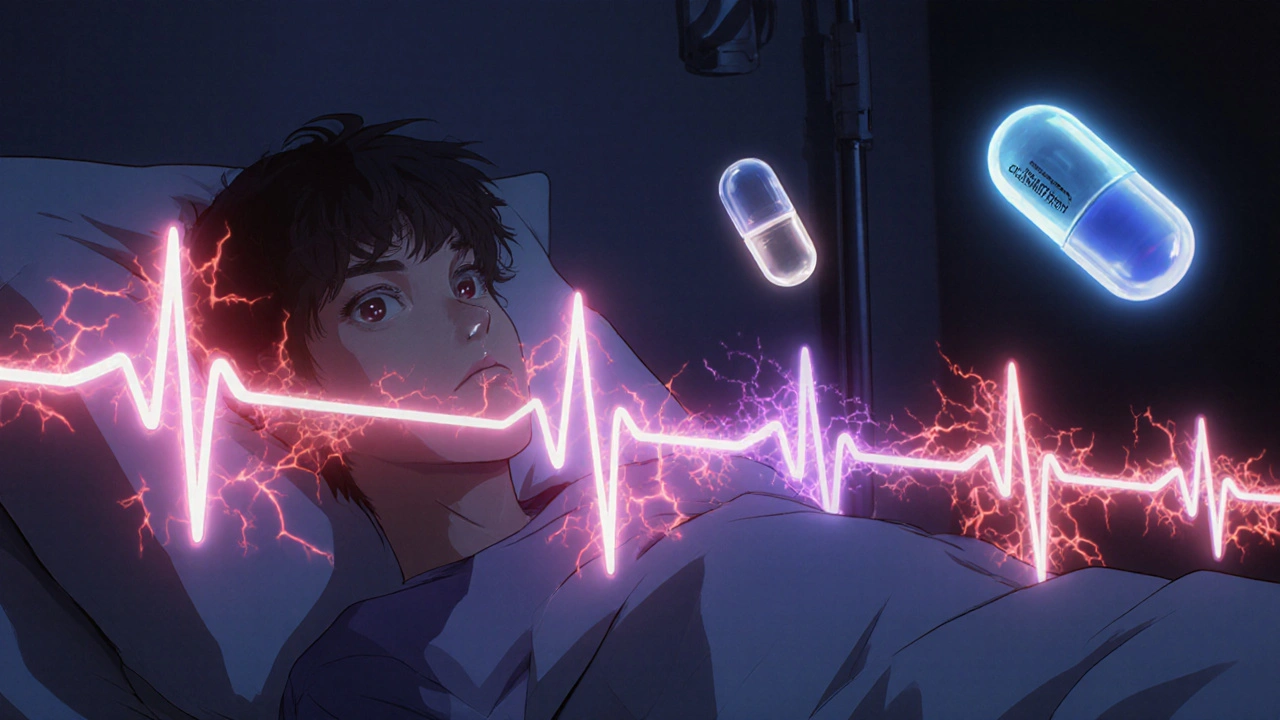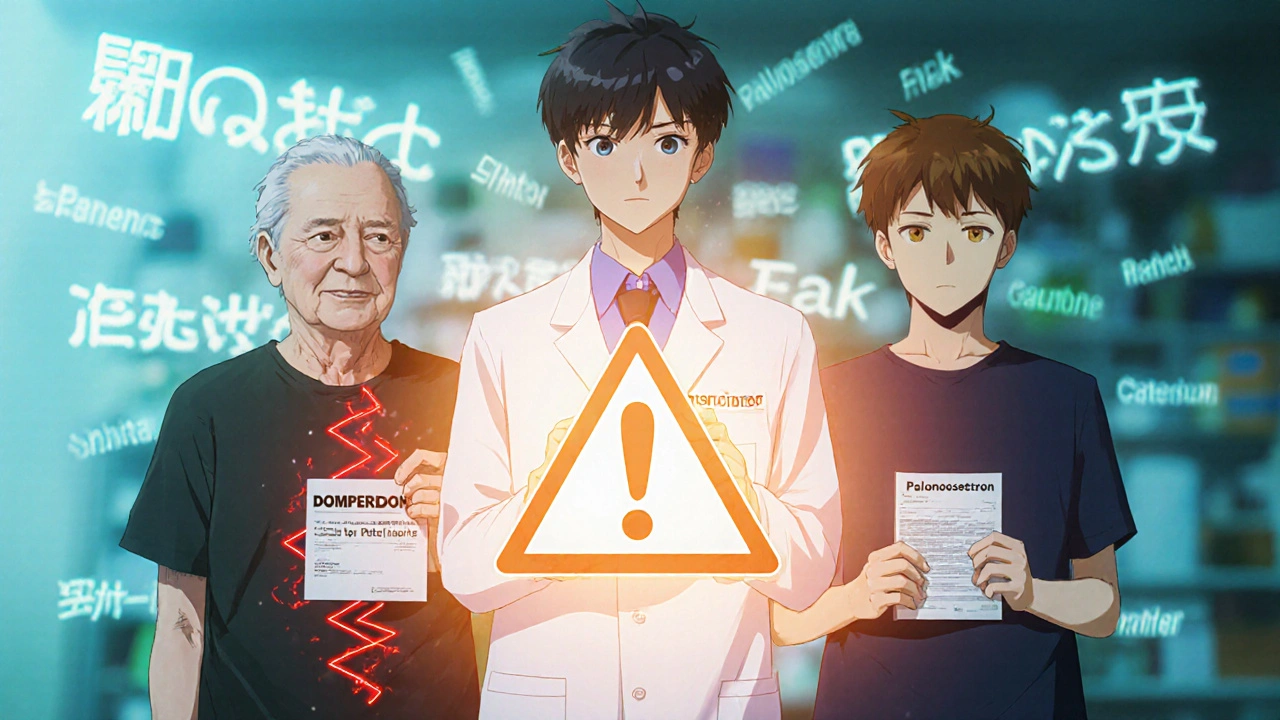Antiemetics and QT Prolongation: What You Need to Know About Drowsiness and Heart Risks
 Nov, 21 2025
Nov, 21 2025
Why Antiemetics Can Be Riskier Than You Think
Most people assume nausea meds are safe-after all, they’re used after surgery, during chemo, or for morning sickness. But some of the most common antiemetics carry hidden risks: they can stretch out your heart’s electrical cycle, leading to a dangerous rhythm called torsades de pointes. Others make you so drowsy you can’t drive or even stand safely. The truth? Not all antiemetics are created equal. Some are gentle. Others? They’re a gamble with your heart.
What Is QT Prolongation-and Why Should You Care?
Your heart beats because of electrical signals. The QT interval on an ECG measures how long it takes for your heart’s lower chambers to recharge between beats. When that interval stretches too long, your heart can misfire. That’s QT prolongation. It doesn’t always cause symptoms. But when it does, it can trigger torsades de pointes-a chaotic, fast heartbeat that can collapse your heart’s pumping action. Sudden death is possible.
Many antiemetics cause this by blocking a key potassium channel (IKr) that helps your heart reset after each beat. The risk isn’t huge for everyone, but it jumps dramatically if you’re older, have heart disease, low potassium or magnesium, or are taking other drugs that also stretch the QT interval. In fact, 91% of reported cases involved people on multiple QT-prolonging drugs. That’s not a coincidence-it’s a pattern.
Which Antiemetics Are Most Likely to Prolong QT?
Not all nausea meds affect your heart the same way. Here’s the breakdown:
- Ondansetron-The most commonly used IV antiemetic in hospitals. At doses over 8 mg, it reliably lengthens the QT interval. Studies show it can stretch QT by up to 20 milliseconds. Though rare, it’s linked to more cases of torsades than other agents in this class. Oral doses are generally safer.
- Granisetron-Also prolongs QT, especially at IV doses over 10 mcg/kg. But transdermal patches appear to have less effect, making them a quieter option for some patients.
- Droperidol-Once feared as a cardiac hazard, newer data shows it’s safer than thought. At antiemetic doses (under 4 mg/day), QT prolongation is minimal. Even 10-20 mg doesn’t always cause issues. Still, caution is needed in high-risk patients.
- Haloperidol-Can prolong QT at cumulative IV doses above 2 mg. But the standard antiemetic dose is just 1 mg. At that level, risk is low.
- Metoclopramide-Crosses the blood-brain barrier, so it causes drowsiness and movement side effects. Also prolongs QT. Not ideal if you have heart or neurological risks.
- Domperidone-Known to prolong QT in theory, but studies in healthy volunteers showed no effect even at 80 mg/day. Still, older adults or those with liver problems may be at higher risk.
- Palonosetron-The quiet star. No QT prolongation. Longer-lasting than ondansetron. Better control of nausea. If you’re worried about heart rhythm, this is often the safest pick.
- Olanzapine-A newer option. No QT effect. Low risk of movement side effects. Less proven for nausea than older drugs, but useful in palliative care.

Drowsiness: The Silent Side Effect
Some antiemetics make you sleepy. Others? You won’t even notice. This matters because drowsiness isn’t just annoying-it’s dangerous if you’re driving, operating machinery, or caring for someone.
- Promethazine-Strong sedative. Often used for motion sickness or pregnancy nausea. Don’t use it if you need to stay alert.
- Prochlorperazine-Low sedation risk. A better choice if you need to work or drive after taking it.
- Metoclopramide-Can cause drowsiness, but more often causes muscle stiffness or tremors. Not ideal for long-term use.
- Palonosetron-No drowsiness. One of the few antiemetics that controls nausea without fogging your brain.
- Dimenhydrinate and Meclizine-Used for motion sickness. Very sedating. Avoid if you’re working or need sharp reflexes.
- Olanzapine-Can cause drowsiness, but less than promethazine. Still, monitor for fatigue.
Who’s at Highest Risk?
You’re more vulnerable if you have:
- Existing heart rhythm problems
- Low potassium or magnesium levels
- Chronic kidney or liver disease
- Are over 65
- Take other QT-prolonging drugs (antibiotics like azithromycin, antidepressants like citalopram, antifungals like fluconazole)
- Are getting IV antiemetics-especially ondansetron
Here’s the reality: if you’re young, healthy, and taking one oral antiemetic with no other meds, your risk is low. But if you’re in the hospital, on chemo, or have multiple health issues? That’s where things get risky.

What Should You Do Instead?
You don’t have to choose between nausea and heart danger. Here’s how to pick smarter:
- For most patients with no heart issues: Ondansetron (oral) is still fine. Avoid IV doses over 8 mg.
- For high-risk patients: Go with palonosetron. It works better, lasts longer, and doesn’t touch your QT interval.
- If drowsiness is a problem: Skip promethazine. Try prochlorperazine or palonosetron.
- If you need something for chronic nausea: Olanzapine is emerging as a safe, effective option-especially in cancer or palliative care.
- For motion sickness: Meclizine or dimenhydrinate work, but avoid if you’re driving. Consider non-medication options like acupressure bands.
And always check: are you on other meds that stretch the QT? Talk to your pharmacist. They can spot dangerous combinations before they happen.
When to Call Your Doctor
Stop the medication and get help if you notice:
- Heart palpitations or skipped beats
- Dizziness or fainting
- Unusual fatigue or confusion
- Severe drowsiness that doesn’t go away
These aren’t normal side effects. They could be early signs of something serious.
The Bottom Line
Antiemetics are lifesavers for nausea-but they’re not harmless. The key is matching the drug to the person. Ondansetron? Fine for a healthy 30-year-old after surgery. Dangerous for a 70-year-old on diuretics with low potassium. Palonosetron? Often the better choice when heart safety matters. Droperidol? Less scary than old warnings suggest. And drowsiness? It’s not just a nuisance-it’s a safety issue.
The goal isn’t to avoid antiemetics. It’s to use them wisely. Ask: Is this the safest option for me? If you’re unsure, ask your doctor or pharmacist for alternatives. Your heart will thank you.
Can I take ondansetron if I have a heart condition?
If you have a known heart rhythm problem, low potassium, or are on other QT-prolonging drugs, avoid IV ondansetron. Oral ondansetron at standard doses (4-8 mg) is usually okay for healthy people, but talk to your doctor first. Palonosetron is a safer alternative if heart safety is a concern.
Is domperidone safe for older adults?
Domperidone can prolong the QT interval, especially in older adults or those with liver problems. While studies in healthy volunteers showed no effect at doses up to 80 mg/day, older patients are more sensitive. Use with caution, and avoid if you have heart disease or are on other QT-prolonging drugs.
Why is palonosetron considered better than ondansetron?
Palonosetron doesn’t prolong the QT interval, lasts much longer (up to 40 hours), and is more effective at preventing nausea-especially after chemotherapy. It’s also less likely to cause headaches. For high-risk patients, it’s often the preferred choice.
Does droperidol really cause dangerous heart rhythms?
The fear around droperidol comes from older studies using high doses. At antiemetic doses (1-2 mg), studies show minimal QT prolongation and no increase in torsades de pointes. The real risk is when it’s used in very high doses or in patients with multiple risk factors. For most people, it’s safer than once thought.
Can I take promethazine for morning sickness?
Promethazine is sometimes used for morning sickness, but it causes strong drowsiness and can lower blood pressure. It’s not linked to QT prolongation, but it’s not the safest choice. Alternatives like pyridoxine (vitamin B6) with doxylamine or palonosetron are often preferred, especially if you need to stay alert.
What’s the safest antiemetic for cancer patients?
For cancer patients, palonosetron is often the top choice-it’s effective for delayed nausea, doesn’t affect the QT interval, and causes less drowsiness than older drugs. Olanzapine is also increasingly used because it helps with nausea and appetite without major heart risks. Avoid ondansetron if you’re on other QT-prolonging chemo drugs.


Srikanth BH
November 23, 2025 AT 00:16Really appreciate this breakdown-so many people just grab ondansetron like it’s candy. I’ve seen nurses give 16mg IV to elderly patients and wonder why they collapse. This post saved me from a bad call last week. Palonosetron is the quiet hero we need more of.
Ellen Sales
November 23, 2025 AT 01:07Wow. Just. Wow. I mean, we think of nausea meds as harmless, right? Like, it’s just a little queasy, pop a pill, done. But this? This is like finding out your favorite coffee cup has lead glaze. My grandma took droperidol after surgery and spent three days in cardiac monitoring. Nobody warned us. Nobody even mentioned QT. It’s terrifying how little we’re told.
Shivam Goel
November 24, 2025 AT 15:04Let’s be real-this post is technically accurate but dangerously oversimplified. Ondansetron isn’t ‘safe’ at oral 8mg, it’s just less risky than IV. And palonosetron? It’s expensive as hell and not always covered. You’re telling people to use it for ‘high-risk’ patients but not addressing cost, access, or formulary restrictions. Also, domperidone isn’t approved in the US because it’s a cardiac liability-stop pretending it’s safe just because some small study didn’t show QT changes in healthy volunteers. That’s not how pharmacovigilance works.
And don’t get me started on olanzapine-yes, no QT effect, but it’s an antipsychotic. You’re casually recommending it for nausea like it’s Advil. That’s not clinical practice, that’s dangerous reductionism.
Andrew McAfee
November 26, 2025 AT 11:42Man, I’m from India and we use promethazine for everything-morning sickness, motion sickness, even colds. No one ever talks about how sleepy it makes you. I once saw my uncle drive home after taking it and nearly hit a tree. We need more awareness here. This post is gold for places where meds are bought off the shelf without a script.
Andrew Camacho
November 26, 2025 AT 15:05So let me get this straight-you’re telling me that hospitals are giving patients a drug that can KILL THEM and calling it ‘standard care’? And you’re acting like this is some new revelation? This isn’t science, this is negligence. And don’t even get me started on how pharma companies bury the data. They knew. They always knew. And now they’re selling palonosetron at 10x the price and calling it ‘premium.’ Classic capitalism. We’re being played.
Jennifer Griffith
November 28, 2025 AT 12:14idk i think people are overreacting. i took ondansetron after chemo and i’m fine. also domperidone is like, banned in the us but available everywhere else? so maybe the us is just being extra? also i think drowsiness is just part of life lol
Kimberley Chronicle
November 28, 2025 AT 17:30Excellent synthesis of clinical evidence. The QT prolongation risk stratification is particularly valuable-especially the emphasis on polypharmacy. In my practice, we’ve shifted to palonosetron as first-line in oncology due to its pharmacokinetic profile and negligible cardiac liability. The 91% polypharmacy stat is the real kicker-clinicians must actively audit concomitant QT-prolonging agents. This deserves wider dissemination.
Pallab Dasgupta
November 29, 2025 AT 14:09Bro. This is life-saving info. I’m a nurse in Mumbai and we used to hand out promethazine like candy. I just told my whole unit about this yesterday. One of the seniors said, ‘But we’ve been doing this for 20 years!’ I said, ‘Yeah, and maybe that’s why three patients had arrhythmias last year.’ We’re switching to palonosetron for chemo patients. No more guesswork. Thank you for this.
Josh Zubkoff
November 30, 2025 AT 12:18Look, I read this whole thing and honestly? It’s just another ‘here’s a list of drugs’ post. You didn’t even mention the FDA black box warning on droperidol from 2001. You didn’t explain why the EMA banned domperidone for nausea in 2014. You didn’t mention the 2017 study that linked ondansetron to increased stillbirth risk in pregnancy. You just cherry-picked the least scary data and called it ‘safe.’ This isn’t education-it’s corporate fluff dressed up as medical advice. People are dying because of lazy summaries like this. And you’re just sitting here patting yourself on the back.
Also, why is palonosetron ‘better’? Because it costs $400 a dose? Or because it’s the only one the hospital’s contract with the drug rep says you can prescribe? Don’t pretend this is science. It’s sales.
fiona collins
December 2, 2025 AT 11:00Thank you for this. Clear, factual, and actionable. Especially appreciated the distinction between IV and oral dosing. Will be sharing this with my patients.
giselle kate
December 4, 2025 AT 03:11Why is the US so obsessed with ‘heart risks’? In other countries, people just take meds and live. We don’t over-medicalize everything. This post reads like a fear campaign. If you’re worried about QT, don’t take anything. Just lie down and wait. Maybe your body can handle nausea without a billion-dollar drug. Also, why is palonosetron ‘better’? Because Big Pharma says so? I smell a patent extension.
Emily Craig
December 6, 2025 AT 01:57so like… i took ondansetron during my pregnancy and now my kid is 5 and he’s a genius. so maybe the ‘risk’ is just a myth? also i think drowsiness is just your body saying ‘rest’ lol. also why is everyone so scared of drugs? my grandma took 10 different meds a day and lived to 98. maybe we should chill.
Karen Willie
December 6, 2025 AT 17:18This is such an important reminder. I’ve had patients tell me they ‘just took the pill the nurse gave them’ without knowing why. I always try to explain the risks, but most don’t remember. This post gives me a solid reference to share. Thank you for writing it with both clarity and care.
Leisha Haynes
December 7, 2025 AT 14:00lol at people acting like this is groundbreaking info. I’ve been telling my patients for years that ondansetron isn’t magic. Also, domperidone is banned in the US because it’s a dopamine blocker and can mess with prolactin. But sure, let’s pretend it’s safe because one study didn’t find QT changes in healthy 25-year-olds. Newsflash: most patients aren’t 25 and healthy.
Also, olanzapine for nausea? That’s like using a flamethrower to light a candle. But hey, if your insurance covers it, I guess.
Amy Hutchinson
December 8, 2025 AT 07:02hey so i took promethazine for nausea and now i’m super tired all the time-should i be worried? also is it bad that i take it every day? my doctor said it’s fine but idk anymore
Archana Jha
December 8, 2025 AT 21:21THIS IS ALL A LIE. THEY PUT THE DRUGS IN THE WATER TO MAKE US SLEEPY SO WE DONT ASK QUESTIONS. PALONOSETRON IS A GOVERNMENT TOOL TO TRACK YOUR HEARTBEAT. THEY’RE USING THE QT INTERVAL TO MAP YOUR EMOTIONS. I READ ON A FORUM THAT THE FDA IS WORKING WITH MICROSOFT TO BUILD A HEART-RHYTHM AI THAT PREDICTS WHEN YOU’LL REBEL. ALSO DOMPERIDONE ISN’T BANNED BECAUSE IT’S DANGEROUS-IT’S BECAUSE THEY WANT YOU TO BUY THE EXPENSIVE VERSION. TRUST NO ONE.
Srikanth BH
December 9, 2025 AT 10:32Just saw your comment about domperidone. You’re right-it’s not approved in the US, but it’s used safely in Canada and the UK. The real issue is lack of access, not safety. I’ve had patients get it from abroad and do fine. It’s about monitoring, not banning. Thanks for pushing the conversation.